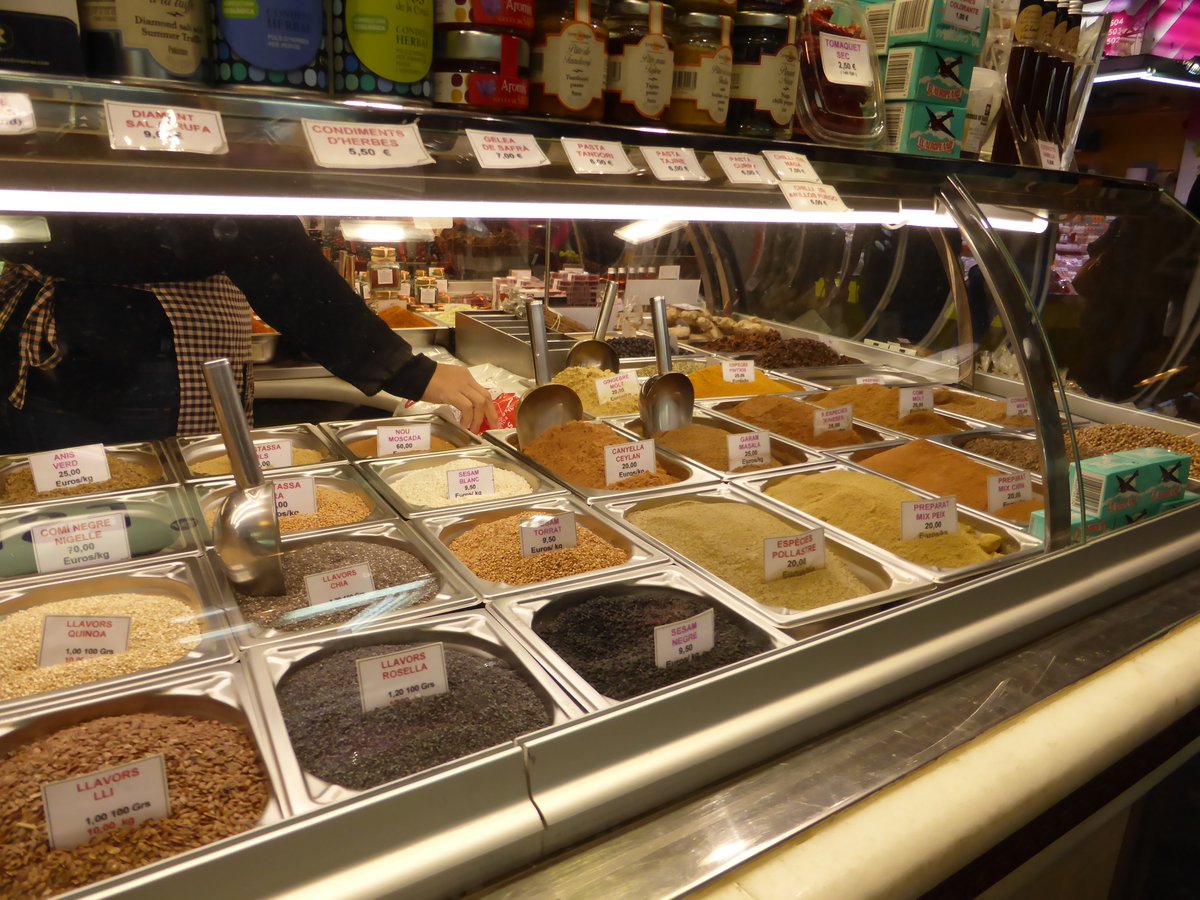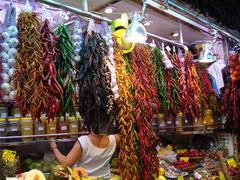
La Boqueria Barcelona: Visiting Hours, Tickets, and Complete Travel Guide
Date: 14/06/2025
Introduction to La Boqueria Market
La Boqueria, officially Mercat de Sant Josep de la Boqueria, is one of Barcelona’s most celebrated landmarks, renowned for its vibrant mix of history, gastronomy, and local life. Located on the iconic La Rambla boulevard, this market has been part of the city’s pulse for over 800 years, evolving from medieval meat stalls to a modern, architecturally striking covered market. Today, La Boqueria is a central hub for food lovers, history enthusiasts, and anyone seeking an authentic Barcelona experience (boqueria.barcelona/history; Lonely Planet).
Historical Overview
Medieval Origins (13th–18th Centuries)
The market’s earliest mention dates to 1217, when butchers established temporary meat stalls outside the city’s walls. The name “Boqueria” is thought to derive from the Catalan word “boc,” meaning billy goat, as goat meat was a staple offering at the time. For centuries, La Boqueria remained informal and open-air, reflecting the city’s changing geography and social dynamics (boqueria.barcelona/history).
18th–19th Century Transformation
Urban development in the late 18th century prompted multiple relocations of market stalls. The destruction of the Convent of St. Joseph in 1835 allowed the city council to establish a permanent market square on the site. Construction began in 1836, and the market was officially inaugurated in 1840, marking its transition into a structured, central institution (boqueria.barcelona/history; locabarcelona.com).
Architectural Evolution (19th–20th Centuries)
The early 20th century brought significant enhancements, notably the iconic Modernist entrance arch designed by Antoni de Falguera in 1913 and the installation of a metal roof in 1914. Major renovations in the late 20th and early 21st centuries modernized the market while honoring its historical character, including the preservation of Ionic columns and the introduction of natural light through a glass awning (boqueria.barcelona/history).
Practical Visitor Information
Visiting Hours
- Monday to Saturday: 8:00 AM – 8:30 PM
- Closed: Sundays and public holidays
Entry and Tickets
- Admission: Free for all visitors; no tickets required
- Special Events and Tours: Some events and guided tours may require advance booking and tickets (thetouristchecklist.com)
How to Get There
- Metro: Liceu (L3 line) and Drassanes (L3 line) stations are nearby.
- Bus: Multiple lines serve La Rambla.
- Walking: Central location; easily accessible from Plaça de Catalunya.
Accessibility
- Wheelchair Access: Ramps at entrances and wide aisles throughout the market.
- Facilities: Restrooms and seating areas available.
Best Times to Visit
- Early Morning (8:00–11:00 AM): Fewer crowds and freshest produce.
- Late Afternoon (after 7:00 PM): Quieter, but some stalls may begin to close.
- Weekdays: Less crowded than weekends (steemit.com).
Market Layout and Offerings
La Boqueria covers approximately 2,500 square meters and hosts over 300 stalls, organized for easy navigation:
- Central Core: Seafood and meat vendors.
- Middle Ring: Cured meats, cheeses, and delicatessen.
- Outer Ring: Fruits, vegetables, nuts, spices, and artisanal products.
- Perimeter: Tapas bars and eateries serving prepared foods (bcn.travel; visitcostablancaspain.com).
Notable Sections and Specialties
- Fresh Produce: Seasonal Catalan fruits, vegetables, and juices.
- Seafood: Mediterranean fish, shellfish, and ready-to-eat dishes.
- Cured Meats: Jamón ibérico, chorizo, fuet, and local sausages.
- Cheeses: Spanish varieties like Manchego and Mahón.
- Tapas Bars: El Quim de la Boqueria, Pinotxo Bar, and others offer classic Catalan dishes.
- Sweets and Gifts: Turrón, panellets, artisanal chocolates, olive oil, and spices.
Food Experiences and Shopping Tips
- Sampling: Many vendors offer free samples—don’t hesitate to ask.
- Payment: Card payments are widely accepted, but carry some cash for small purchases.
- Photography: Always ask before taking photos of vendors or displays.
- Crowd Avoidance: Visit early or late, and explore deeper into the market for a more authentic experience (seethebigworld.com).
Cultural Significance
La Boqueria is a symbol of Barcelona’s culinary tradition and community spirit. Many stalls are run by families who have passed down their trade for generations, preserving traditional recipes and foodways (Explorial.com). The market is also a stage for culinary education, hosting cooking classes, food fairs, and cultural events that highlight Catalan gastronomy (thetouristchecklist.com).
Community Role and Tourism
While La Boqueria attracts millions of visitors annually, it remains a vital source of fresh ingredients for locals and a community hub for the surrounding neighborhoods. The market’s popularity has led to both increased economic vitality and challenges related to overcrowding and sustainability. Measures such as group size limits and responsible tourism campaigns aim to balance the needs of locals and tourists (Academia.edu).
Nearby Attractions
- La Rambla: The city’s iconic pedestrian boulevard.
- Gothic Quarter: Historic district with medieval streets.
- Plaça Reial: Elegant square with palm trees and lively nightlife.
- Gran Teatre del Liceu: Barcelona’s historic opera house.
- Palau Güell: A nearby UNESCO World Heritage site.
Special Events and Guided Tours
La Boqueria offers guided tours, cooking classes, and occasional food festivals. These experiences provide insight into market history, Catalan ingredients, and local culinary traditions. Booking in advance is recommended for tours and classes (Justroyalbcn.com).
Practical Tips for Visitors
- Arrive Early: For the best selection and fewer crowds.
- Bring a Reusable Bag: For sustainable shopping.
- Watch Your Belongings: Pickpocketing can occur, especially near entrances (eurocheapo.com).
- Dress Comfortably: Wear shoes with good grip.
- Respect Local Etiquette: This is a working market for locals as well as a tourist site.
Frequently Asked Questions (FAQ)
Q: What are La Boqueria’s opening hours?
A: Monday to Saturday, 8:00 AM to 8:30 PM. Closed on Sundays and public holidays.
Q: Is entry free?
A: Yes, entry is free. Tickets may be needed for tours or events.
Q: Is the market wheelchair accessible?
A: Yes, ramps and wide aisles ensure accessibility.
Q: Can I pay by credit card?
A: Most stalls accept cards, but cash is recommended for small purchases.
Q: Are guided tours available?
A: Yes, multiple operators offer tours and cooking classes.
Q: What is the best time to visit?
A: Early mornings on weekdays are least crowded.
Summary and Visitor Tips
La Boqueria is a living symbol of Barcelona’s culinary and social traditions, offering a unique blend of history, vibrant atmosphere, and exceptional food. Free to enter and easily accessible, the market is a must-visit for any trip to Barcelona. Enhance your experience by arriving early, taking a guided tour, and exploring both the stalls and nearby attractions. For the latest updates, download the Audiala mobile app and check official sources for special events and tours.
 Caption: The iconic Modernist entrance arch designed by Antoni de Falguera.
Caption: The iconic Modernist entrance arch designed by Antoni de Falguera.
 Caption: Colorful and lively stalls inside La Boqueria Market.
Caption: Colorful and lively stalls inside La Boqueria Market.
Interactive Map of La Boqueria and Surroundings
Sources and Further Reading
- La Boqueria Market History
- Guide to Mercat de la Boqueria Barcelona (Lonely Planet)
- History & Architecture: Boqueria Market (LocaBarcelona)
- Mercat de la Boqueria Overview (Barcelona.com)
- La Boqueria Market Visitor Guide (The Tourist Checklist)
- Visiting La Boqueria Market (Barcelona Hotels Info)
- La Boqueria Market Layout and Tips (bcn.travel)
- La Boqueria Highlights (visitcostablancaspain.com)
- Barcelona Tourist Guide: La Boqueria
- Culinary Experiences at La Boqueria (Spanish Sabores)
- Right Way to See La Boqueria (eurocheapo.com)
- La Boqueria Market Review (seethebigworld.com)
- La Boqueria: Arts & Culture (Touristsecrets.com)
- Food Market Touristification: The Case of La Boqueria (Academia.edu)
- La Boqueria Market Sights (Explorial.com)
- Just Royal BCN: La Boqueria






























































